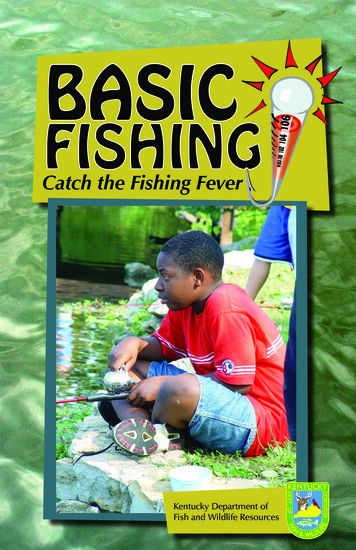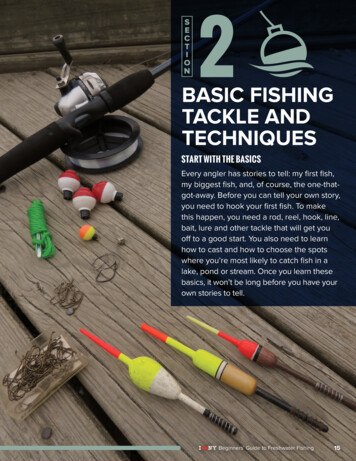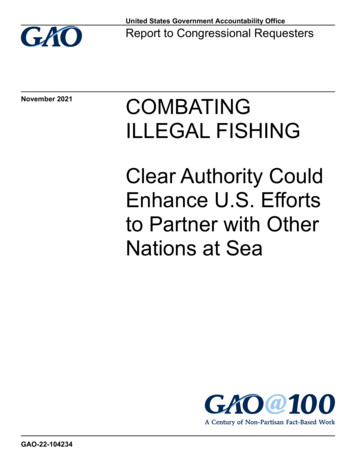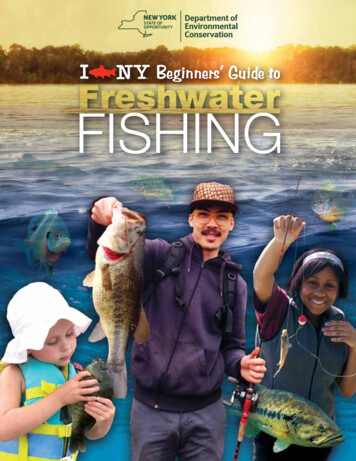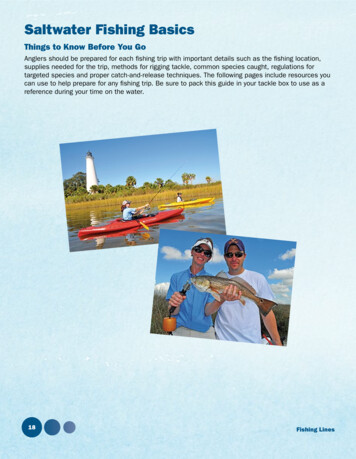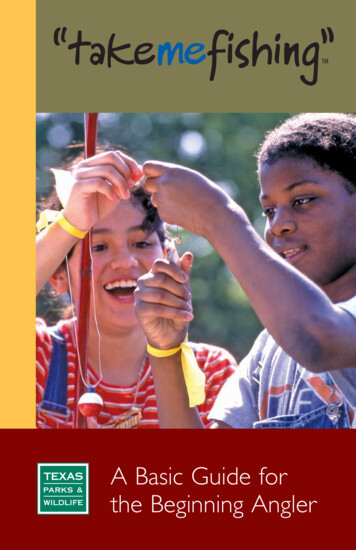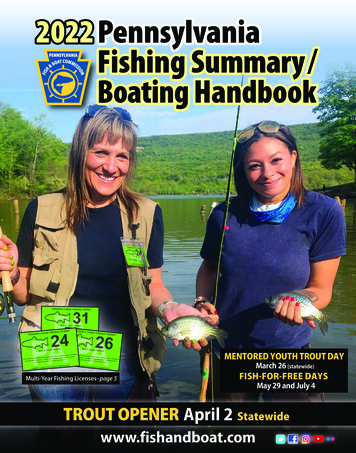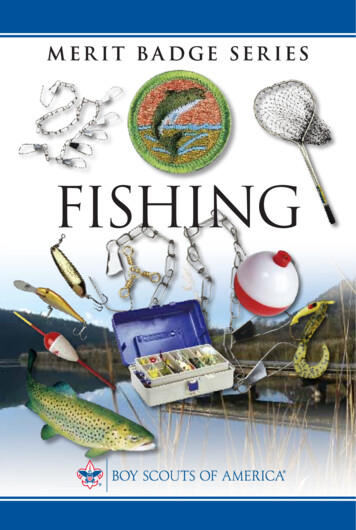
Transcription
fishing
BOY SCOUTS OF AMERICAMERIT BADGE SERIESFishing
Requirements1. Do the following:a. Discuss the prevention of and treatment for thefollowing health concerns that could occur whilefishing, including cuts and scratches, puncturewounds, insect bites, hypothermia, dehydration,heat exhaustion, heatstroke, and sunburn.b. Explain how to remove a hook that has lodged inyour arm.c. Name and explain five safety practices you shouldalways follow while fishing.2. Discuss the differences between two types of fishing outfits.Point out and identify the parts of several types of rodsand reels. Explain how and when each wouldbe used. Review with your counselorhow to care for this equipment.35899ISBN 978-0-8395-3231-6 2009 Boy Scouts of America2009 EditionBANG/Brainerd, MN10-2009/050876
3. Demonstrate the proper use of two different types offishing equipment.4. Demonstrate how to tie the following knots: clinch,Palomar, turle, blood loop (barrel knot), and doublesurgeon’s loop. Explain how and when each knot is used.5. Name and identify five basic artificial lures and fivenatural baits and explain how to fish with them. Explainwhy baitfish are not to be released.6. Do the following:a. E xplain the importance of practicing Leave No Tracetechniques. Discuss the positive effects of Leave NoTrace on fishing resources.b. D iscuss the meaning and importance of catch and release.Describe how to properly release a fish safely to the water.7. Obtain and review the regulations affecting game fishingwhere you live. Explain why they were adopted and whatis accomplished by following them.8. Explain what good outdoor sportsmanlike behavior is andhow it relates to anglers. Tell how the Outdoor Code of theBoy Scouts of America relates to a fishing sports enthusiast,including the aspects of littering, trespassing, courteousbehavior, and obeying fishing regulations.9. Catch at least one fish. If regulations and health concernspermit, clean and cook a fish you have caught. Otherwise,acquire a fish and cook it.fishing3
ContentsIntroduction . . . . . . . . . . . . . . . . . . . . . . . . . . . . . . . . . . . . . 6The Nature of Fish . . . . . . . . . . . . . . . . . . . . . . . . . . . . . . . . 9Freshwater Fish. . . . . . . . . . . . . . . . . . . . . . . . . . . . . . . . . . . 23Saltwater Fish. . . . . . . . . . . . . . . . . . . . . . . . . . . . . . . . . . . . 35Balanced Tackle. . . . . . . . . . . . . . . . . . . . . . . . . . . . . . . . . . 39Fishing Gear and Craft. . . . . . . . . . . . . . . . . . . . . . . . . . . . . . 62Safety Practices. . . . . . . . . . . . . . . . . . . . . . . . . . . . . . . . . . . 69Cleaning, Filleting, and Cooking Fish. . . . . . . . . . . . . . . . . . . 76Protecting Game Fish Resources. . . . . . . . . . . . . . . . . . . . . . . 81Glossary. . . . . . . . . . . . . . . . . . . . . . . . . . . . . . . . . . . . . . . . 92Fishing Resources. . . . . . . . . . . . . . . . . . . . . . . . . . . . . . . . . 94fishing5
Introduction.IntroductionThis pamphlet will tell you a lot about fish and how to catchthem. You might catch them for fun and “sport,” or to eat.Fishing can become a lifetime pursuit, like golf or tennis.Many kinds of fish are described here, along with many waysto catch them—there are always new challenges in fishing,and always more to learn. This is one merit badge you aresure to enjoy earning from the very start.As for beginnings, fishing has a long and interestinghistory. As soon as early humans discovered that therewere fish in the waters and that the fish were goodto eat, they began to devise methods for catchingthose fish. They quickly found that it was easier tospear fish than to grab them with their hands. Later,they discovered that they could catch even more fishby using woven nets.After observing fish while they were feeding, these earlypeoples began making sport of catching fish by putting a sliverof bone inside a bait with a thong fastened to the middle ofthe bone. When the fish grabbed the bait and swallowed it,the piece of bone caught crosswise inside the fish, allowing itto be pulled in. This birth of angling, long before humans beganrecording history, led to the invention of fishhooks, made firstof bone and later of metal.The initial intent of catching fish was to get food. However,even early humans found that trying to outwit a fish with a lineand bait was an intriguing pursuit with considerable excitementwhen a big fish latched on to the hook. Eventually, fishingevolved into a sport, and anglers devised finer, lighter tackle,making it more challenging to hook a fish and giving the fishan opportunity to beat anglers at their own game. Thus wasborn the sport of fishing, distinct from commercial fishing orfishing for food.6fishing
.IntroductionBaden-Powell’s Love of FishingRobert S. S. Baden-Powell, the founder of the Scouting movement,claimed fishing as one of his favorite pastimes. As the ChiefScout of the growing Scouting movement during the early20th century, Lord Baden-Powell traveled the world to attendjamborees and provide leadership and inspiration. Everywherehe went, his fishing rods, reels, and fishing kit went with him.Baden-Powell’s biographer E. E. Reynolds wrote, “When heneeded to get right away from everything and everybody, hewould go off for a few days’ fishing.”In Scouting for Boys, Baden-Powell offers this advice to theyoung fisherman: “Every Scout ought to be able to fish in orderto get food for himself. A tenderfoot [beginner] who starved onthe bank of a river full of fish would look very silly, yet it mighthappen to one who had never learned to catch fish.”It’s no surprise that fishing remains a favorite pastime onScout outings.In his bookLessons Fromthe Varsity of Life,Baden-Powelldeclares, “Troutfishing is the bestrest-cure inthe world.”fishing7
.The Nature of FishThe Nature of FishFish are highly specialized aquatic creatures, amazinglyconstructed for living in water. Here are some interestingfacts about fish. They are cold-blooded—their body temperature is about thesame as the water around them. Not all fish have scales, but all fish are covered with athin skin. Scales are protective plates that are covered by the skin.When a scale is lost, its “pocket” can become infectedbefore the skin heals over and a new scale develops. Scales develop annual rings much like those of a tree.A fish’s scales can help determine its age. The muscles and fins of fish are designed to propel themthrough the water in search of food and to help themescape from enemies. Fish breathe mainly through gills that take oxygen from thewater and send it into the bloodstream while simultaneouslyremoving carbon dioxide from the fish.Some fishspecies areespecially smart.Any experiencedangler who hastried to catchthe “old lunker”that has lived inthe same poolfor years willswear to that.Most fish reproduce by the female laying eggs that themale fertilizes in the water. The females of some speciesmay lay millions of eggs, while some other species lay onlya few hundred. Fish have the senses of sight,taste, smell, hearing, and touch, as well asother special senses to helpthem survive.fishing9
The Nature of Fish.Parts of a FishAnal fin. Used for balanceand swimming.Pectoral fin. Used for stability,locomotion, and steering.Caudal fin. Used in swimming,particularly when a fish needs aquick thrust of speed.Pelvic fin. Used for steeringand stability.Eye. Most fish have monocularvision—each eye sees separately,offering a wide field of view.Gills. Respiratory organs usedfor breathing.Jaws. Bony appendages thatform a fish’s mouth. They may beequipped with teeth so that a fishcan grip its prey while feeding.Scales. Transparent protectiveplates growing from the skinthat can be replaced if lost.Soft dorsal fin. Used for balanceand forward movement.Spiny dorsal fin. The forward fin,supported by sharp spines, isused for balance. The spines alsoprotect the fish from its enemies.Lateral line. A sensory organ thatdetects sound and movement.EyeSpinydorsal finGills (underneath)JawsSoftdorsal finScalesPectoral finPelvic finScaleLateral lineAnal finCaudal fin10fishing
Toothy FishBeware! Some common fish that you may catch, like the pike andpickerel in ponds, or bluefish in salt water, have very sharp teeth.Do not “land” them by grasping their mouth. Their teeth are therefor snatching their prey—not your fingers.The Food ChainAs you practice the sport of fishing,you will learn about the wateryworld of fish, a complex environmentthat provides the food fish eat. At thebottom of the chain are plankton—minute creatures that are eaten byother forms of aquatic life, includingsome of the fish. In freshwater,there are countless insects that creep,crawl, and live in the water, eventually climbing or flying out of thewater to mate, drop their eggs, andstart another cycle of life. Fish andother creatures feed on these insects.fishing11
The Nature of Fish.Large predatorfish may eatinsects, frogs,crayfish, andother fish—evenmembers of theirown families.12fishingCrayfish hide under rocks and eat anything alive or deadthey come across. Tadpoles swim in the shallows, developinginto frogs that live on the shorelines. Small fish, includingminnows, eat smaller forms of aquatic life andin turn are eaten by larger forms. The luresyou use will imitate these forms of food.The food chain starts with thesmallest being eaten by largercreatures. In turn, those crittersare eaten by something else.At the top of the chain are fishand the creatures that feedupon fish, including eagles,ospreys, mink, otters, bears,and, of course, humans.
.The Nature of FishReading Nature’s SignsLocating lakes and streams where there are fish is easy. Everystate conservation department has lists or maps showing allthe fishing waters and which types of fish are in them. Tackleshops, sporting magazines, and friendly anglers are your mostconvenient sources of information on where to fish. Don’t beshy in asking for information about local fishing spots. Butonce on the water, where are the fish?Fish feed oninsect larvaeyear-round.Larvae are themainstay oftheir diet.Fish MovementGame fish often come to the surface, sometimesleaping clear out of the water for food. Theexperienced angler searches for signs as to howa fish is feeding—whether a fish is surfacing orseeking food just beneath the surface. The angleris alert to the flash of sun on scales underwateror to the movement of a fish’s shadow.Insect ActivityInsect life hatches continually year-round.The appearance of insects such as mayflies andcaddis flies indicates that an abundance of larvae iscrawling and swimming below, which means that fishare probably feeding on them.fishing13
The Nature of Fish.Where to Find FishFish can be found just about anywhere there is clean water.Fish live in bodies of water as small as a pond or as large asthe ocean.Some pondowners plant lilypads or othervegetation toprovide shade,cover, and placesfor fish tocongregate sothey will beeasier to catch.14fishingA pond can have many species of fish at all depths.PondsProperly managed ponds can be high producers of fish,providing excellent angling. Most ponds contain game fishsuch as bluegills and largemouth bass along the shoreline,adjacent to weed cover, or in the colder deep waters. Pondsare relatively easy to fish because they are small.In hot weather, game fish may seek the deeper areas.Fishing at varied depths is one way to locate schools of fish.Many ponds have bullheads or catfish living at the bottom.These fish are relatively easy to catch on live bait fisheddown to where they live.
.The Nature of FishLakesLakes are larger bodies of water and a popular place forsportfishing. Most anglers can find several lakes within easydriving distance that provide a variety of environments for fish.Rock bassShallows. Most of the food and most of the cover, such asweeds and sunken trees, are found near shore. Thus, most fishat times will be found near the shallows, moving in and out tofeed. Some species, such as panfishes and pike, tend to spendmost of their time in shallow water. Others, such as the bassand walleye, move in and out at different times of day andunder different conditions of weather and temperature.Breakline. The breakline is where the shallow waters drop offtoward the deep water. It is a place where many species of fishtend to congregate, waiting for the opportunity to feed.Structure. Rocks, ledges, reefs, bars, and sunken obstructions,found in or near deep water, can be holding spots for schoolsof fish. These hangouts are used by various species betweentimes when they move up to the breakline or into the shallowsto feed.fishing15
The Nature of Fish.StreamsStream fishing for trout and salmon has a special attraction toanglers who learn to fish moving waters. The constant movement of a stream presents a natural challenge for an angler.Depending on the time of year, streams can be full of troutor salmon returning from saltwater to spawn. These fish drawanglers from miles around to try their luck.Rapids. Where water rushes into a pool, crashing down overthe boulders or thundering in from a waterfall, fish tend togather. These are places where food collects and can easily becaptured by the fish. Rushing water is highly aerated, whichcreates a cool, oxygen-filled environment. Some fish such astrout regularly live in such places, which are hatching sites fora variety of insects that trout prefer for food.Cutaway Banks. Fish tend to hide where stream currentshave carved holes under a bend in the shore, particularlywhere there are trees and exposed roots. Deep, quiet channelsalso are good spots to locate fish in streams.16fishing
.The Nature of FishBig WaterWith an environment as big as the ocean, you canexpect to find bigger fish. Deep-sea fishing for someof the world’s largest species has become a popularsporting pastime.Surf. Some spectacular angling is availableon the edge of the nation’s two oceans andalong the coast of the Great Lakes. Long castsrequire specialized tackle.Extreme caremust be takenwhen waves getbig, during tidalmovementscausing undertow,or when slipperyrocks are present.Surf fishing today is most often done with heavy-dutyspinning tackle, although some saltwater casting is done withbait-casting outfits. Lures or baits require a long rod with plentyof backbone to get out beyond the shallows to where the fishlie. Surf rods are built with long handles for casting with twohands, using a sweeping motion, overhead and to the side.Hundreds of lures are designed to take the variety of sportfish found in salt water. Various types of live bait and cut-upbait also can be bottom-fished for saltwater species. In theGreat Lakes, surf angling is highly effective for salmon andtrout. Chest-high waders or hip boots may be necessary toget into the edge of the surf.fishing17
The Nature of Fish.Most saltwater anglers beach small fish and use a net toland the larger ones so the fish can be released alive. Great Lakesanglers most often use large landing nets, preferably with acompanion handling the net while the angler concentrates onthe fish.Offshore. Trolling and still-fishing or drifting are the usual usesof boats in salt water, the Great Lakes, and the nation’s bigimpoundments. Offshore saltwater trolling for swordfish, tuna,sailfish, shark, and other big species requires large fishing craftand heavy tackle. Most of this type of fishing is on charterboats with experienced guides.A variety of saltwater fishing can be done with outboardcraft and medium-weight tackle for anglers who may troll, cast,or bottom-fish. Party boats with experienced captains take largenumbers of anglers to reefs where game fish are taken onbaited hooks dropped over the side.Great Lakes trollers have specialized equipment—planingboards and lead-weighted downriggers—designed to get luresout to the sides of the boats or deep down. Sometimes theboats are allowed to drift, with the anglers simply jigging luresup and down or sending live bait to swim around below.18fishing
.The Nature of FishWhere Fish HideFish hide for two principal reasons: to conceal themselvesfrom enemies and to ambush unwary prey swimming past.In the shallows, fish are found around weed beds, underneathoverhanging trees and brush, near docks, and where rocksjut out from the shore. In deep water,fish are quite often found aroundclusters of big boulders wherethey conceal themselves inthe shadows.Factors Affecting FishBehaviorSince before recorded history,fishermen have studied fish,trying to determine whatconditions cause fish to bitemore readily. There is adefinite correlation betweenweather and fish action,usually with a spurt offeeding just before aweather front arrives.Fronts can be anticipatedby a drop in atmosphericpressure, measured ona barometer. Normalbarometric pressure is 30at sea level. Low is below30 and high is above 30.An approaching low, withSunken trees that have fallen into the waterare sure hangouts for almost all species ofthe barometer declining, oftengame fish.indicates an approaching storm.Similarly, a rising barometeroften indicates clearing weather.Water temperature has a definite effect on fish. For instance,trout cannot endure water temperatures greater than 70 degrees.A sudden drop in temperature often will cause fish to stopbiting. This is quite common after a storm passes. Risingtemperature often causes fish to bite. In coastal areas, thetides have a strong influence on fish behavior.fishing19
The Nature of Fish.SeasonsSpring usually finds the water cold but warming, with the bestfishing on the warmer days. Spring is when many species arespawning, a time when they tend to strike lures quite readily.More fish are caught in summer than in any other season.It is a time when more anglers are fishing and also when thewater temperature is rising, speeding up the metabolism of fishand causing them to feed more.Fall can provide some excellent fishing, particularly whenthere are warm days and cool nights. Cold fall days often arenot productive.Winter usually is associated with ice fishing. Watertemperature under the ice is low but usually stable. Somespecies of fish—trout, pike, perch, walleye, and panfish—bitereadily in winter.20fishing
.The Nature of FishWhy Fish BiteFish react to various stimuli, not all of which have beendetermined. But when a bait or lure sets off the “trigger,”the fish strikes.All species of fish have certain times of the daywhen they feed. Some of the periods seem to coincidewith phases of the moon and tides, some with weather,some with time of day. Early morning and late eveningare usually times when fish are active, but there areother times, even after dark.In most instances fish bite because theyare hungry. As an angler, you willimitate the kind of food you believewill attract a feeding fish. Your luremay imitate a minnow or a mayfly;your style of fishing may be witha spinning rod, casting reel androd, or fly-fishing.School fish, such as whitebass, go on feeding frenzies,chasing swarms of bait fish andgulping down as many as they can.Then they stop abruptly and cruisealong ignoring the same bait fish theywere chasing a few moments before.Fish can be “spooked” orturned off by the intrusion ofa noisy boat or a noisy wader,by a badly presented baitor lure, by too big a hook,by a heavy line or leader thatmay be visible, or by ashadow falling on the water.There is an old saying: “If youcan see the fish, they can seeyou.” And sometimes they justwon’t bite, period.With experience,the angler learnswhen and whereeach species ismore apt to takea bait or lure.Rainbow troutArctic graylinefishing21
.Freshwater FishFreshwater FishLakes, ponds, rivers, and streams are home to manyhard-fighting species. Fishing can be done from the shore,dock, while wading, or by watercraft such as a motorboator canoe.Walleye and PerchWalleye and perch are amongthe finest game fishin North America.The walleye isparticularly prizedbecause it grows to alarge size and is very tasty.Many anglers troll for walleye, using minnowlike luresweighted down deep, jigs tipped with live bait,spinner-and-bait combinations, or just live bait with aslip sinker. Slowly trolling over sunken bars, alongsideledges and weed beds, and over sand flats (particularlythose parallel to the breakline) can be effective.WalleyeIn early morning and evening,walleye may be taken by casting lures; excellent catches ofwalleye can sometimes bemade late at night on slowlyretrieved floating-diving lures.Numerous walleye are caughtevery year by still-fishing livebait either on the bottom or witha slip bobber.fishing23
Freshwater Fish.Yellow perch are abundantand willing to bite almostanytime. These fish providea lot of action when a schoolis located. The most popularmethod of perch fishing is withminnows, worms, or leeches ona small hook below a bobber. Tinyjigs, 1 8 to 1 16 ounce, with a piece ofworm on the hook, often do thetrick. In the spring, perch gatherwhere streams enter lakesand where there are damsin rivers. They may betaken in large numbers witha streamer fly or a smallspinner fished on a fly rod.Yellow perchWhite perchWhile perch will never take any trophies as fighters,they are fun to catch in large numbers and they makea tasty fish fry.Largemouth BassNo fish was more aptly named than the largemouth bass. Itsjaw extends well back past its eye, and when it opens its mouthto swallow something, it seldom misses. Because of its abilityto take a wide variety of lures and because it often strikesexplosively on the surface, the largemouth is one of the mostprized and highly sought game fish in North America. The firstreels and casting rods made in the United States were tailoredto bass fishing.Largemouth bass24fishing
.Freshwater FishLargemouth can be caught on bait-casting,spin-casting, spinning, and fly tackle. They willhit floating lures, floating-diving lures, andbottom-bumping jigs. Weedless spoons andspinner baits that will not snag on vegetationwhen fished through the lily pads, often areproductive. Pork rind lures, pork “eels,” andplastic worms also are effective. Largemouth alsowill hit bait of live minnows, frogs, leeches, andcrayfish, which are life-forms that are naturally foundin their habitat and are part of their accustomed diet.In the South, largemouth grow to 20 pounds or more.In the North, 10 pounds is a record-breaker. Largemouth arestructure fish, meaning they hang around brush, fallen trees,weed beds, and ledges, usually in fairly shallow water. Wherethey are heavily fished, they become cagey, and the anglermust be careful, quiet, and skillful to be successful.In areas wherefishing pressureis heavy, manyanglers releasethe bass theySmallmouth Basscatch, perhapsAveraging between 4 and 6 pounds, the smallmouth bass hasbeen described as “pound for pound, the gamest fish thatswims.” Many anglers will argue for other species, but thereis no question that this snub-nosed, jut-jawed warrior of thecold water is a foe to test the tackle of any angler.keeping one ortwo small onesfor supper. Smallbass are excellenteating; big bassare not as good.Smallmouth bassThe easiest way to distinguish the smallmouth fromits largemouth cousin is by the upper jaw. In thesmallmouth bass the jaw comes to a point just tothe eye. In the largemouth, the upper jaw ends behindthe eye. Also, smallmouth are yellow or tan with brownmarkings. The largemouth is a greenish-gray color withblack markings. Both fish are known as black bass.fishing25
Freshwater Fish.Smallmouth once were confined to the eastern UnitedStates but have been stocked over all of the northern states,much of Canada, and parts of the southern United States. Nightcrawlers, leeches, minnows, frogs, and hellgrammites (a type ofaquatic insect larvae) are all natural food for this fish. It alsowill hit a wide variety of spinners, floating-diving lures, surfacelures, flies, plastic worms and bugs, and jigs.However, unlike the largemouth, which often will hit afast-moving lure, the smallmouth likes its bait moving slowly,with frequent pauses and twitches. When it does strike, however, it strikes like lightning. The battle is spectacular, playingout as much above the surface as in the water. Its preferredhangouts are fallen trees, underwater cabbage beds, rockledges, and deep boulder piles. In the spring thesmallmouth is up in the shallows, but inthe summer, it may be down 10 to 30feet. In the late fall, the smallmouthschools at 40 feet.Striped BassIn salt water, striped bass range along the East Coast fromMaine to North Carolina, and are a favorite of anglers who fishin the surf. Originally a saltwater species, several hundreds ofthese fish were trapped while spawning in the Santee Riverwhen the dam was built for South Carolina’s Santee-Cooperhydroelectric project in 1938. Surprisingly, the stripers adaptedto freshwater, spread over the reservoir, and grew rapidly, someto more than 40 pounds.Since then, they have been successfully stocked in a numberof reservoirs, creating a new inland game fish sport. Stripedbass are strong fighters and usually are taken on light saltwatertackle. Most stripers are caught on live shad minnows, althoughcasting heavy jigs and spoons can workwell when the fish are feeding.Anglers locate schools ofstripers by watching theseagulls circling swarmsof bait fish chasedto the surface byfeeding bass.Striped bass26fishing
.Freshwater FishPanfishThis year, a million American young people will be introducedto the sport of fishing, and most of them will catch a speciesof panfish. Aptly named, the many species that make up thiscategory are some of the tastiest in the frying pan. They alsoare fun to catch, and some are ferocious battlers, despite theirrelatively small size.While panfish may be taken on almost any kind of pole,line, rod, and reel, catching these bantamweight warriorson a fly rod or ultralight spinning tackle is great sport.Panfish are highly susceptible to flies and tiny jigs. Theyalso bite small panfish popping bugs, size 10 or 12, duringthe warm months when insects are hatching.Rock Bass and Bluegill. The rockbass, a member of the sunfishfamily, is a brassy-colored fishwith rows of black scales anddistinctive red eyes. A stubby fightergrowing to 2 pounds that will strikealmost any kind of live bait or artificial lure,it likes to hang out around old bridge piers,docks, boulders, and weed beds. Except inthe late fall when it goes deep, the rock bassis a shallow-water feeder that likes to takeminnows and bugs near the surface.The bluegill, like many of thesunfishes, has a shiny, dark bluepatch on the edge of the gill cover.Also, like its sunfish cousins, it isbrightly colored. The bluegill haspurplish sides with black bands anda bright yellow or orange throat. It has asmall mouth, and small hooks are required tocatch it. Bluegill are found just about all over theUnited States and grow to 2 pounds, although1-pounders are considered good catches. They are oneof the toughest fighters among the sunfish clan.Rock bassBluegillfishing27
Freshwater Fish.Crappie. Silver and black, the crappie grows to 4 pounds,although a 2-pounder is considered a trophy in most areas.It feeds mainly on small minnows and insects and will takesmall spinners and lures without hesitation. The crappie isoften found close to structure. Be aware that the crappie hasa paperlike mouth and must be carefully handled so that thehook does not pull loose. It is excellent eating.CatfishSmooth-skinned and scaleless, long, lean, and builtfor power, the catfish family is widespread inNorth America. Catfish are found in clear,icy waters of the North as well as the warm,muddy streams and bayous of the South.They are highly tolerant of water temperaturefluctuations and can withstand turbid water,even some pollution. They are relatively easyto catch, are fierce fighters, and make for fineeating when properly prepared. Be careful:All catfish have sharp spines in the pectoraland dorsal fins that can cause a painful woundto the unwary or careless angler.CatfishChannel catfish are sleek and highly prized. They cangrow to 30 pounds or more, but the average is 2 or 3 pounds.Flathead catfish and blue catfish regularly grow to more than40 pounds, some reaching 100 pounds. The most common catfish is the much smaller bullhead—a dweller of small streams,ponds, and sloughs. Thousands of bullheads are caught eachyear by anglers with no more than a hook, line, and bait. Largercatfish are found below dams, in riffles, beneath undercutbanks and logjams, and in deep holes and channels. The bestway to catch them is to fish the bait on bottom.28fishing
.Freshwater FishCatfish BaitNearly any bait, alive or dead, will take a catfish. Channel cats, at times,will strike a lure as savagely as a walleye. Some favorite catfish baits arecut-up smelts or other small fish, worms bunched up on a hook, clammeat that has been allowed to mellow in the sun, and crayfish tails.Catfish also like liver, chicken entrails, and cheese. Commercial “stinkbaits,” which have a strong odor, also are good.cut-up smeltswormsclam meatcrayfish tailsThe Pike FamilyBig, sharp-toothed, and mean-tempered, the fish that make upthe pike family have a common trait: They strike first and askquestions later.Pikes must becarefully handledto avoid contactwith their teeth.fishing29
Freshwater Fish.Northern pikeMuskellungeMembers of thepike family areexcellent eatingbut are bony.Northern Pike. Most common is the northern pike, found overa large part of North America. They may grow to 50 pounds.All of the pikes prefer large, flashy lures such as spinners,spoons, silvery floating-diving plugs, and noisy surface baits.They strike big minnows and will readily take strips of suckermeat or frozen smelts.Muskellunge (Muskies). Biggest of the pike family, these fishgrow to more than 60 pounds. The true muskie is li
they come across. Tadpoles swim in the shallows, developing into frogs that live on the shorelines. Small fish, including minnows, eat smaller forms of aquatic life and in turn are eaten by larger forms. The lures you use will imitate these forms of food. The food chain starts with the sma
